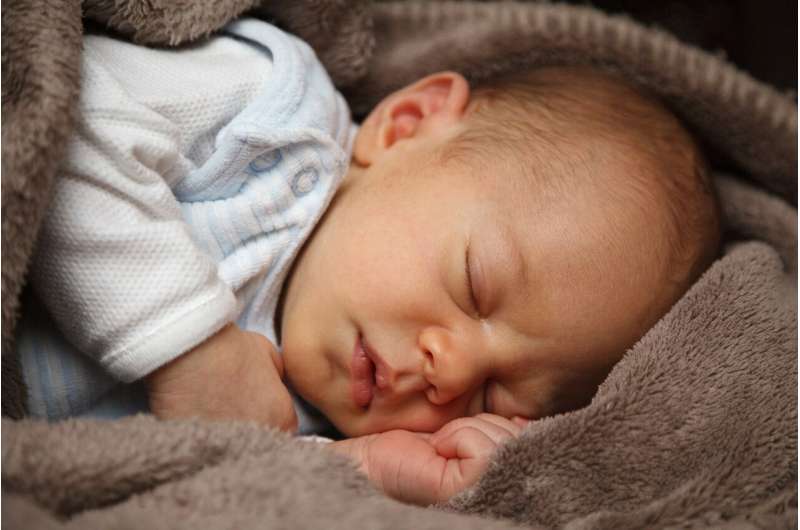This article has been reviewed according to Science X's editorial process and policies. Editors have highlighted the following attributes while ensuring the content's credibility:
fact-checked
reputable news agency
proofread
Summer heat is especially dangerous for babies and toddlers. Here's how to protect them

As extreme summer heat continues to grip the region, young children are at a greater risk for heat exhaustion and heat stroke.
It's important to understand the signs of danger for youngsters as well as the best ways to keep them safe.
Know how to spot the symptoms of overheating and heat stroke.
Young children and babies are more vulnerable to the heat than others. Babies, especially those under 6 months old, cannot control their body temperature well, according to Dr. Chandani DeZure, a spokesperson for the American Academy of Pediatrics and a pediatrician in Palo Alto. It's important to check up on your young ones frequently because they might not be able to tell you if something is wrong.
Keep an eye on whether your baby or toddler is extra fussy or fatigued, experiencing muscle cramps, vomiting or feeling nauseous, as this could indicate they are overheating. Overheated babies won't want to feed as much as usual.
If you see your child has hot and dry skin, is breathing rapidly, has a rapid heart rate or is no perspiring—or barely perspiring—these could be a sign of heatstroke.
"Fatigue sets in from being in the sun for so long and it can, in severe situations, lead to seizures and strokes," DeZure said. "We don't want it to get to that point."
Monitor your child's play and make sure they take frequent breaks.
Young kids are active, but it's important to make sure they don't overextend themselves when temperatures are high. Have them play in the shade or indoors during peak sun hours—typically between 10 a.m. and 4 p.m.—and don't plan anything too strenuous to do on hotter days, DeZure said.
Dr. Anu Seshadri, lead physician at UCLA Health in Century City, especially recommends keeping them indoors if the temperature passes 90 degrees.
Even when youngsters play outside during cooler morning and afternoon hours, DeZure recommends limiting time outside to two hours and include frequent water breaks.
Keep your young ones out of the heat.
It's especially important to shield babies from direct sunlight, especially if they are under 6 months old. If you do bring them outdoors in a stroller, make sure not to drape a thick stroller blanket over it because that can actually trap the heat, according to Seshadri. Instead use an umbrella to block the sun and allow for ventilation.
Don't leave your kids in a car either, even if the windows are open. The temperature within a car can rise fairly quickly—nearly 20 degrees within the first 10 minutes, according to the Centers for Disease Control and Prevention.
For homes without air conditioning, Seshadri suggests putting a bucket of ice in front of the fan to help circulate chilled air around the room. However, she recommends against using a fan when it's over 90 degrees because it won't do more than move hot air around, she said.
Do not give your child a cold water bath because the temperature of the water can actually affect their core body temperature, especially among babies, Seshadri said. Instead, use lukewarm water and a sponge to cool them off or spray them with mist.
Keep them covered.
Clothing should be loose and breathable, but cover the skin. Materials like cotton and linen are best. Light colors help too because they reflect the sun's rays. Use a brimmed hat to keep your child's face out of direct sunlight. Babies, especially, should be covered as much as possible to avoid the sun.
Make sure to reapply sunscreen every two hours. Doctors don't typically recommend putting sunscreen on babies under 6 months old but, DeZure suggests applying just a little bit to the parts of the baby that aren't covered by clothing if they are in direct sunlight—as long as those aren't areas a baby can put in their mouth like their hands. Make sure sunscreen includes protection from both UVA and UVB rays and is mineral based. DeZure also recommends checking out sun protective clothing that has SPF built into it.
At night, keep clothing to a minimum. Dress them in looser, more breathable clothing and tuck toddlers into bed with a sheet rather than a blanket. Leave babies in just a diaper, Seshadri recommends. Babies shouldn't have anything near them when they sleep regardless of weather to minimize risk of suffocation.
Keep them hydrated.
Make water as easily accessible as you can, but also have fruit and salad readily available for your children if you can. Those foods are great avenues for hydration as well, according to Seshadri.
Make sure you serve as a role model for your kids. Hydrate often so that they can be encouraged to do so too.
"Like when kids see that mom and dad or their friends are hydrating, then you're going to do the same thing too," Seshadri said. "Instead of just forcing them to drink water, you drink that water too."
Make sure your daycare is adapting to the heat.
Ask your child's day-care provider how they deal with the heat. Check with them about sunscreen application, hydration and playtime routines outside. Ask them what kinds of food they are serving. If they don't have air conditioning, what alternatives do they have to keep kids cool?
Day care facilities should have policies that dictate how much time kids spend in direct sunlight, DeZure said.
©2023 Los Angeles Times.
Distributed by Tribune Content Agency, LLC.


















